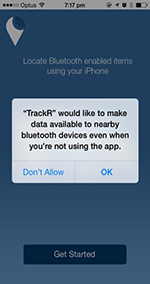There’s been a lot of hype recently about the arrival of Beacon technology.
Embracing communication at a micro-location level, Beacon technology will be key to enabling publishers and marketers to improve their relevance to consumers.
Although the technology behind Beacon – Bluetooth Low Energy (BLE) – has been in development for some time, the widespread rush of excitement has only just taken off. That is in part due to Apple’s publication of a standard for it, the inclusion of it in its iOS 7.1+ software, and Google’s inclusion of it in the Android 4.3+ operating system.
That makes Beacon one of the first cross-platform micro-location technologies available to the majority of smartphone app developers and users today.
Unlike traditional Bluetooth, or other platforms such as NFC and QR codes, Beacon allows the delivery of content and push notifications, and even the initiation of payments, without users needing to open an app or have their phone screens active.

So what impact and benefits might this technology bring to publishing?
With ever-increasing volumes of advertising targeting consumers whose default response is “delete”, the battleground for publishers and marketers is relevance.
That means that if an ad is completely relevant to a consumer right here, right now, it might get some of their time. Leveraging the frictionless, real world context that Beacon technology opens up will push publishers into a greater world of relevancy.
So how might that be done?
1. Greater accountability
Picture the ability to connect a customer’s online profile and your ads to their real-world actions. Not just “did they click on a campaign and view a product page?” but “did they then turn up at the retail outlet, visit the area of the store where the product is located, and buy it?” If you are first to demonstrate that your audience and advertising medium created effective, real-world activity, such as store visits, you’ve just made a compelling reason for grabbing more of the marketing budget.
2. Increase the take
You walk past a local restaurant and a notification lets you know that the restaurant was recently voted as the Good Food Guide’s best seafood restaurant for the year. You are shown the latest review, available tables and given a special offer. After your meal, a notification asks if you want to contribute a user review. The review is automatically validated as being authentic because the Beacon technology will know you have spent a certain amount of time at the restaurant. That review is then instantly published across other platforms keeping content updated and relevant while also helping SEO.
3. Break down walls
With publications such as The Australian Financial Review and The Sydney Morning Herald using paid subscription models, Beacon devices could allow mobile users in spaces such as airports and waiting rooms to snack on unlimited content that is unlocked within a specified range through the local WiFi. That allows publishers to showcase relevant content at the right time. It also allows them to harvest new subscribers with a subscription prompt when the user has left the proximity of that local WiFi hotspot, after having received targeted and highly relevant content and advertising.
4. Extra relevancy
The focus on content relevancy by publishers in recent times always centres on questions such as: “Who are my readers”‘ and “On what devices are they consuming content?” But with the rise of location-based technology such as Beacon, publishers will soon also need to address the question: “Where will my content be most relevant?” The battleground for relevancy now has many more vectors than before. It’s not just publishing on a national, state, city or even neighbourhood basis. Beacon opens up new, contextual locations such as sporting grounds, specialty stores or restaurants.
5. More pull for your push
While many case studies focus on the push side of Beacon technology, the amount of data being pulled and gathered offers publishers great benefit. Partnering with leading proximity companies such as Localz.co, publishers with existing distribution networks, such as news agencies, can begin to harvest real world data today. Why limit yourself to your own Beacon network? Publishers can also collaborate with marketers willing to share their Beacon data. Knowing which areas of a store were visited, or if a purchase was made, allows publishers to help marketers run more relevant campaigns. And it helps form a tighter bond with the merchant in the process..
What’s clear is that the impact of Beacon on publishers will be more about influence than disruption. Regardless of whether their customers are banks, airlines, events, retailers or supermarkets, a big chunk of a publisher’s advertising revenue comes from businesses with a physical presence.
They are the businesses that will be the first to adopt and feel the impact of Beacon. And as the use of this technology matures, expect to see all of the above use cases for publishers come to fruition.
Steven is a lateral thinking product leader whose horizons span both the corporate and start-up realm in Australasia. He works at Fairfax Media where he is on a quest to turn audiences into customers.